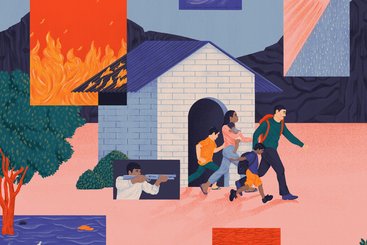What makes our lives liveable? We all have different answers to this – myriad aspects give our lives meaning and value. But what if our needs, desires, aspirations and agency were routinely overlooked, and instead our lives were reduced to mere survival? This is the case for countless people in situations of protracted crisis: the humanitarian aid system works to keep them alive in the most ‘efficient’ way possible, but it often fails to consider what kinds of lives it is saving.
The unintended but very real harms of humanitarian action
People affected by crises are not passive – they demonstrate adaptation and resistance in countless contexts. They endeavour to make life liveable beyond survival by maintaining hope for the future, developing a sense of place and belonging in displacement, or reconstructing the social relationships and connections that ascribe meaning and purpose to their actions. However, the decisions and assumptions aid actors make about who and what to prioritise, the mechanisms and techniques they use to administer and deliver assistance, and the nature of their relationships with affected people can often end up working against these efforts.
Wellbeing: a more comprehensive approach
The concept of wellbeing helps us think more clearly about how humanitarian aid might better enable people to live the kinds of lives they want to live. Wellbeing takes as its starting point the idea that humanitarian experience needs to be understood holistically. It’s an active process, where people’s efforts to lead good and flourishing lives involve the interplay of material, subjective and relational dimensions of life, played out in specific places, and over time.
The interplay of wellbeing and humanitarian action: food, sex and death
We’ve recently published a working paper exploring how struggles for wellbeing play out in humanitarian crises. To make things as tangible as possible, we zoomed in on three crucial aspects of the human experience – food, sex and death – to understand how people’s efforts to live good, meaningful lives can often clash with what humanitarian action considers important.
Food is a subjective experience – it tastes of something and inspires certain sensations or feelings – as well as a relational phenomenon – how people consume and share these calories helps give life shape and meaning. Liberian refugees have described how ‘nutritious’ food to them was food that tasted good and felt nourishing – it wasn’t just about ‘sustaining biological life’. Food also has cultural meaning, with certain dishes, ingredients or methods of cultivation linked to specific and significant places, memories or practices. These elements can be critical in enabling people to piece together a semblance of a normal life in protracted crisis settings. Yet with humanitarian organisations tending to envision effectiveness in terms of reach and cost per beneficiary, food tasting good or being culturally appropriate is not high on their list. Being given the same, tasteless food every single day is often experienced in stark terms by affected people, who may feel that this is evidence of the limited value humanitarians place on their lives, that they are being deliberately disciplined or dehumanised.
Similar issues come into play when it comes to growing and producing food. For example, Karen refugees in Thailand go to significant and often expensive lengths to grow herbs, crops, and other plants native to their pre-displacement home in Myanmar. But the relevance of gardening and food production for refugees is often ignored by humanitarian actors; the phenomenon may even be suppressed as a nuisance and potential safety hazard disrupting the orderly layout of a planned camp.
Questions of sex and intimacy in humanitarian settings tend largely to be framed within the language of sexual and reproductive health and rights (SRHR). This encompasses, for example, maternal, newborn and child health; preventing sexually transmitted infections, especially HIV; and mitigating the impact of gender-based violence with a focus on sexual violence. But reading between the lines of how most approaches to SRHR tend to handle sex, we can also see two problematic assumptions emerging: first, that sex in crisis settings is universally fraught with risks and harm; and second, that certain groups of people – namely, those who may be subject to safeguarding concerns, such as adolescents or people with disabilities – have no sexuality at all.
Focusing on sex as a problem to be solved or a risk to be avoided ultimately reflects a poor understanding of the central role it plays in people’s efforts to live meaningful lives and to pursue healthy, fulfilling relationships. A more wellbeing-centred approach would address harms, yes, but it would also place more emphasis on making space for people to explore and foster healthy sexualities – and not necessarily just heterosexual, monogamous sex. Part of this would involve thinking through in more depth how different aspects of humanitarian action might impact these dynamics – such as the role of privacy in shelter and settlement design, or how information and behaviour-change campaigns around child protection handle the thorny subject of adolescent sexuality.
Death is as much a part of life as living, and is crucial to its understanding. In a study of displaced Georgians, for example, rituals of death and mourning offered a powerful, if painful, opportunity to repair some of the ruptures brought about by crisis and displacement, and re-establish some sense of normal life. Stuck as they were in displacement camps, burying their dead according to the proper rites in the soil of the camp offered a symbolic way to reimagine the blank, sterile space they inhabited as at least partially contiguous to the meaningful place of the villages they had left behind.
Humanitarian action can play an important role in enabling or constraining how people are able to process the difficult experience of death and dying in a crisis setting. For Mozambican refugees in Malawi, the provision of resources by humanitarian organisations to enable an appropriate burial represented a ‘valuable service’ and was a significant advance in humanitarian programming, but this only occurred on an organisation-by-organisation basis and was not systematically part of programming. Instead, ‘the use of blankets for burial has frequently led to friction between refugees and assistance agencies’.
Beyond survival: wellbeing as ethical obligation in humanitarian action
In protracted crises in particular, humanitarian assistance that starts out with the goal of saving lives inevitably ends up sustaining and shaping them as well. While engaging with issues beyond survival might seem like a secondary priority or ‘out of scope’, failing to do so can result in programming that is ineffective, wasteful, harmful, and that misses out on valuable opportunities to have a positive impact on people’s lives.
We’re not arguing here for opening up a new area of expertise in humanitarian action – doing ‘wellbeing programming’ or opening up a ‘wellbeing sector’ is all too likely to replicate the same old problems. Rather, we believe that wellbeing offers value for humanitarian actors as a way to think and act more carefully, in ways that make good on the often-repeated but seldom realised promise to put people at the centre of humanitarian action. This means, for example, having open and potentially uncomfortable conversations with people about what the future holds, and enabling them to lead in defining and pursuing their preferred ways through it. It means extending conversations around localisation beyond questions of financing and risk to acknowledge and support types of assistance delivered through contextually grounded idioms and values. And it means moving beyond the humanitarian–development–peace nexus, beyond questions of financing and coordination to a basic operating principle, acknowledging that people’s needs in crises always exist on a continuum with their wider experiences, desires and aspirations.







